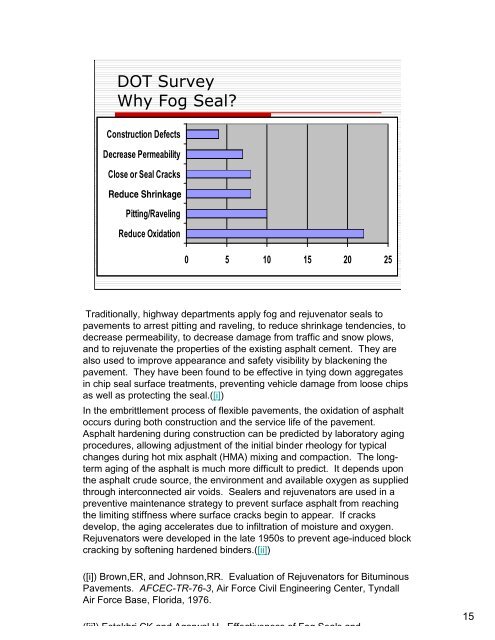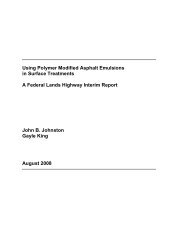Spray Applied Polymer Surface Seals - TSP2
Spray Applied Polymer Surface Seals - TSP2
Spray Applied Polymer Surface Seals - TSP2
You also want an ePaper? Increase the reach of your titles
YUMPU automatically turns print PDFs into web optimized ePapers that Google loves.
DOT Survey<br />
Why Fog Seal?<br />
Construction Defects<br />
Decrease Permeability<br />
Close or Seal Cracks<br />
Reduce Shrinkdage Shrinkage<br />
Pitting/Raveling<br />
Reduce Oxidation<br />
0 5 10 15 20 25<br />
Traditionally, highway departments apply fog and rejuvenator seals to<br />
pavements to arrest pitting and raveling, to reduce shrinkage tendencies, to<br />
decrease permeability, to decrease damage from traffic and snow plows,<br />
and to rejuvenate the properties of the existing asphalt cement. They are<br />
also used to improve appearance and safety visibility by blackening the<br />
pavement. They have been found to be effective in tying down aggregates<br />
in chip seal surface treatments, preventing vehicle damage from loose chips<br />
as well as protecting the seal.([i])<br />
In the embrittlement process of flexible pavements, the oxidation of asphalt<br />
occurs during both construction and the service life of the pavement.<br />
Asphalt hardening during construction can be predicted by laboratory aging<br />
procedures, allowing adjustment of the initial binder rheology for typical<br />
changes during hot mix asphalt (HMA) mixing and compaction. The longterm<br />
aging of the asphalt is much more difficult to predict. It depends upon<br />
the asphalt crude source, the environment and available oxygen as supplied<br />
through interconnected air voids. Sealers and rejuvenators are used in a<br />
preventive maintenance strategy to prevent surface asphalt from reaching<br />
the limiting stiffness where surface cracks begin to appear. If cracks<br />
develop, the aging accelerates due to infiltration of moisture and oxygen.<br />
Rejuvenators were developed in the late 1950s to prevent age-induced block<br />
cracking by softening hardened binders.([ii])<br />
([i]) Brown,ER, and Johnson,RR. Evaluation of Rejuvenators for Bituminous<br />
Pavements. AFCEC-TR-76-3, Air Force Civil Engineering Center, Tyndall<br />
Air Force Base, Florida, 1976.<br />
([ii]) Estakhri CK and Agarwal H<br />
Effectiveness of Fog <strong>Seals</strong> and<br />
15
















